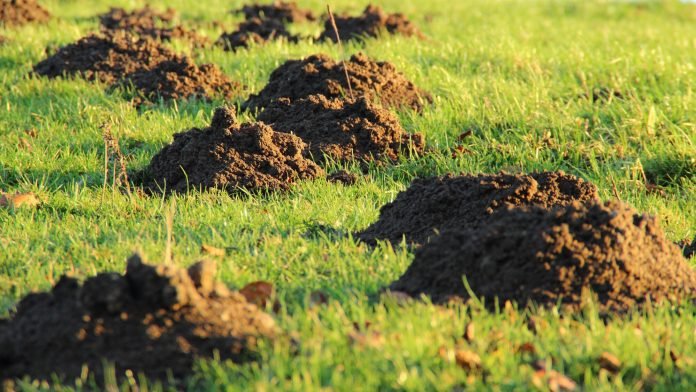Last Updated on June 12, 2023 by
As insectivores, moles are closely linked to bats! Many people are taken aback when they learn that moles are not rodents. Many also don’t realize that moles do not consume your plants. They only eat vegetation on rare occasions. So what’s the issue then? Yard moles can harm your plants and flowers by creating air pockets around the roots. They can also wreak severe damage to your grass and yard by excavating holes, as you would expect.
But, because moles spend almost all of their lives underground, it’s doubtful that you’ll ever see one in your yard. Most yard owners just see the wake of destruction they leave behind.
Yet, how can you get rid of them without harming them?
Well, here are a few humane remedies to help them ship out!
Table of Contents
Signs of Moles In Yard
Mole damage is sometimes mistaken for other pest species, including ground squirrels, gophers, voles, and rats.
What makes it even more challenging to determine whether you’re dealing with moles is the fact that you’ll almost certainly never see the animal. Like we said already, most of the time, you’ll only witness the damage they’ve caused.
Mounds and elevated ridges are the most common evidence of moles. These tend to occur along the pathway margins, roads, and foundations where the soil is moister. This is also usually where you’ll find the most grubs and worms, their favorite snack!
Furthermore, raised-up mole runs can make flower beds feel spongy as if a sinkhole is forming.
You might also have asked the question: Can moles cause foundation damage? If so, the answer is yes, and we suggest you look further into the matter before severe damage occurs.
Moles vs. Gophers
One of the most common animals that people mistake for moles is gophers.
Here are the main differences between the two animals, which can help you figure out if you have moles or gophers in your yard:
- Gophers don’t eat other animals – They are strict vegetarians, whereas moles eat insects. You’re dealing with a gopher, not a mole, if your plants are being consumed.
- Gophers do not leave clods behind – The presence of clods of earth, or large clumps of soil, indicates the presence of moles. When there are moles in your yard, these clods will be there.
- Gophers, unlike moles, do not dig surface tunnels – They build dens and tunnels deep below, usually about 6 feet below the surface, and then emerge to feed.
So after learning this information, you should be closer to identifying what’s lurking under your yard.
Yard Mole Signs Checklist
If you still aren’t sure whether its a mole or some other creature that’s messing up your yard, here’s a quick checklist of yard mole signs to look for:
- You’ll see dirt mounds that are circular and symmetrical.
- Clods are present, and the dirt appears fluffed up.
- Along borders of man-made paths, tunnels and mounds form.
- Molehills can reach a diameter of over a foot.
- The majority of the harm occurs in shady, wet places.
How to Get Rid of Moles In Yard
Now that you’ve established that you do have yard moles, it’s time to get rid of them nicely.
It is not advisable to kill or otherwise injure moles to get rid of them. Moles can be helpful to gardeners in some ways if there are only a few of them.
They can aid in soil aeration and the eradication of hazardous insect populations. So, it might be that you don’t want to rid yourself of moles completely but just reduce their numbers.
Of course, the decision to get rid of them is entirely yours, and it’s understandable given the extent of the damage to your yard. Regardless, moles have a purpose in the ecology, so poisons and traps can be harmful.
Therefore, we recommend concentrating solely on humane ways to get rid of moles in your yard.
Remove Grubs From Your Yard
You don’t want to get rid of the earthworms if you garden, but you can try to get rid of the grubs to reduce the food supply for moles.
You should consider using beneficial nematodes in your garden. They’re a great natural pest control solution that doesn’t harm anything except the grubs. Wildlife, earthworms, humans, and pets are all unaffected.
Plant Daffodils and Marigolds
Planting daffodils, alliums, or marigolds in your yard is a gentle way to keep moles away.
It has no adverse effects on them or the other creatures in the region. It merely encourages the moles to leave and discourages them from returning since they despise these plants.
Some individuals recommend planting castor beans or mole plants as a mole deterrent. However, keep in mind that these are harmful and should be avoided. Daffodils and marigolds are our top picks.
Marigolds, in particular, are a good choice because the more aromatic types are also known to repel deer and rabbits too.
Dry Your Yard Out
Moles prefer damp, shaded soil, so you might want to dry it out a little.
Don’t dry it enough to ruin your garden, but enough to affect the grub and earthworm populations.
It’s as easy as reducing the amount of water applied to the affected area! If the site is very shady, consider cutting the bushes and branches that are in the way to allow more light in.
Catch Them and Release Somewhere Else
Catching and releasing live moles is a difficult task. It’s one of the more difficult species to catch because it rarely comes to the surface.
Do some careful research to reveal many approaches, and you’ll notice that they’re not your typical catch-and-release trap setup.
You’ll have to attempt these other tactics to get the moles to come to the surface while keeping an eye on your yard. You must respond swiftly once you notice them making their way up.
Deal With Your Yard Moles
Now you should have a much better idea of dealing with yard moles in a humane manner. Of course, it might take a little effort on your part to make them sniff around elsewhere, but it will be worth it.
Read More: The 5 Uses of Yard Signs You Need
Thanks for checking in, and please see our blog for more informative pieces. Good luck!
Apart from that, if you are interested to know about Landscape Design then visit our Home Improvement category.



























